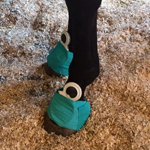Dr. Natalie Diamanti

Dr. Natalie Diamanti is the owner of Pegasus Veterinary Services, a mobile integrative practice based out of Rhode Island. Dr. Natalie completed an ambulatory and surgical internship at Rhinebeck Equine after graduating from St. George's University School of Veterinary Medicine. It was the experience and knowledge she gained during her internship that led Dr. Natalie to pursue certification in integrative therapies. She is a certified veterinary acupuncturist (CVA), certified in animal chiropractic through Options for Animals Chiropractic College and equine kinesiology taping through Equi-Tape. Dr. Natalie has also been an approved provider for the Assisi Loop. Growing up, Dr. Natalie was avid in 4-H in various horse, poultry, rabbit and teen clubs. Later she was a member and captain of the URI Equestrian Team, competing in the Novice and Intermediate divisions. In her free time, Dr. Natalie enjoys making memories with her husband, Jim, their son, and two Great Danes. The website for the practice is: www.PegasusVets.com
In the Loop with Five Common Equine Medical Issues
 Like human athletes, equestrian champions have some special medical concerns that can be more severe or more urgent than their more leisurely counterparts. To get a feel for what types of issues equine athletes come up against most often, Assisi spoke with renowned racehorse trainer Ron Gurfein about the vexing issues he saw most often in the thousands of horses he worked with since he entered the industry in the 1960s.
Like human athletes, equestrian champions have some special medical concerns that can be more severe or more urgent than their more leisurely counterparts. To get a feel for what types of issues equine athletes come up against most often, Assisi spoke with renowned racehorse trainer Ron Gurfein about the vexing issues he saw most often in the thousands of horses he worked with since he entered the industry in the 1960s.
We then took Gurfein’s list of issues to Dr. Natalie Diamanti, a veterinarian certified in animal chiropractic and owner of Pegasus Veterinary Services (pegasusvets.com) in Rhode Island and New York. Dr. Diamanti, who is an Approved Provider of the Assisi Loop, discussed how the Loop could help these powerful performers achieve their goals; we did also single out two issues for which the Loop may not treat the underlying cause, but could still help secondary related issues and aid other treatment.
Soft-tissue damage: Bowed tendons, pulled suspensories, torn ligaments, etc.
 Dr. Diamanti: “My recommendations for these types of injuries when prescribing the Assisi Loop would involve wrapping the Loop over the affected area and using it three to four times a day for a minimum of two weeks, then decreasing to two times a day until the injury has been resolved as per their regular veterinarian. They can then continue to use the Loop once per day, decreasing to every other day and then as needed as they continue through rehabilitation and increasing their workload.”
Dr. Diamanti: “My recommendations for these types of injuries when prescribing the Assisi Loop would involve wrapping the Loop over the affected area and using it three to four times a day for a minimum of two weeks, then decreasing to two times a day until the injury has been resolved as per their regular veterinarian. They can then continue to use the Loop once per day, decreasing to every other day and then as needed as they continue through rehabilitation and increasing their workload.”

Strains; felled ankles, knees, suspensories (not including tears)
“My recommendation for strains are to use the Assisi Loop two to three times per day until resolution. Depending on the strained area, the issue should be resolved within two to four weeks when coupled with appropriate rest.”
Any instability due to neurological issues
While this is a really broad issue and would depend on what is causing the neurologic issue, there are still steps that can be taken, Dr. Diamanti says. “If it is arthritic in nature or a narrowing of the spinal column (i.e.: wobbler), I would recommend starting the Assisi Loop immediately and using it three to four times a day for at least two weeks, but potentially up to four depending on the severity and the amount of improvement noted. Once there is a 25% improvement noted, then I would have them back down to two to three times a day until we appreciate another 25% improvement. If that degree of improvement is not possible due to the nature of the neurologic issue, I would then suggest using it daily to maintain the improvement gained until we feel that the improvement is stable, then attempt to try every other day treatments with the hopes of treating as needed.”
Bone issues: arthritis in particular

“The Assisi Loop for arthritis is a wonderful add-on tool. I prescribe the Loop to be used two to three times per day for two weeks and then decrease to one to three times per day for another one to two weeks, then one time daily for a week and finally as needed. If the horse becomes sore after a hard workout I recommend bumping up the treatments for a day or two then backing down again. I think using the Loop in conjunction with routine Western medicine (joint injections) when appropriate really allows the injections to last longer.”
EPM and its complications are one of the most difficult issues to diagnose and treat, because EPM (a neurologic disorder) can present as a variety of other issues.
“EPM is difficult as the lesions are in the brain, brain stem or spinal cord. The inflammation affects the whole body and the drugs prescribed to treat EPM, the associated inflammation and the protozoal die off are given to hit the horse systemically,” Dr. Diamanti writes. “I don’t think I would prescribe the Assisi Loop for this issue specifically (perhaps if the horse injured itself due to the ataxia they tend to present with, then I would prescribe it for an EPM-related injury) as I would want to treat the whole horse and I just do not think that would be feasible with the small unit.”
The most insidious problem Gurfein could think of was “tying up:” a mysterious build-up of lactic acid that seems to come on randomly, disappear randomly, and feels like a terrible muscle cramp. So, while this was Gurfein’s number-one problem, we’ve listed it last because, since there isn’t an acutely located cause, it is difficult to say whether the Loop would be of assistance. However, Dr. Diamanti did have some musings on the subject:
“The clinical signs of tying up can be varied from horse to horse so it is difficult to give a concise application for the Assisi Loop. There is also a large area on the horse that can be affected, however, the hind quarter muscles are usually most affected. If I were to prescribe the Assisi Loop for a horse that is known to tie-up I would probably recommend they place it over the large gluteal muscles and hamstrings, rotating each side and each muscle group every two hours (as per the Loop recommendations for obtaining the most treatments) until symptoms resolve.”
If you’d like to hear more about Gurfein’s expertise in harness racing, horse training, where to eat in New York or about his favorite movies, check out his column “Ask the Guru” at harnessracingupdate.com. He currently resides in Florida.
